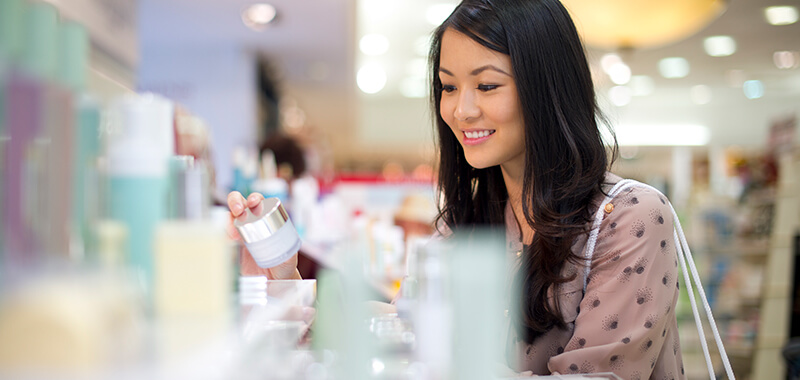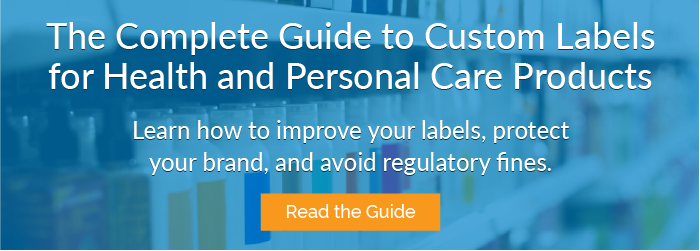
After over a year of obscuring ourselves behind masks and computer screens, people are showing their faces to the world again. And that means cosmetics sales, which took a tumble during the pandemic, will soon be climbing again.
So, as you make plans to win over these reemerging consumers, it’s time to make sure your product looks its best.
In today’s article, we’ll offer cosmetic label printing tips for creating an eye-catching, high-quality custom label that will help your brand make a splash in the post-pandemic beauty market.
Cosmetic Label Printing Matters More Than Ever
It doesn’t take a cosmetic industry analyst to understand why makeup sales plummeted in 2020. Products such as lipstick and blush are difficult (and pointless, many consumers found) to wear beneath a mask.
Makeup sales also declined because people were unable to try on products in stores, and as unemployment swelled, consumers had less money to spend on nonessential items. For consumers working from home, there may have seemed to be little point in putting on makeup anymore.
Now, however, as mask mandates lift and people return to working and socializing in person, consumers want to shake off lockdown and have some fun again with their look. That means the cosmetic industry is well on its way to a rebound: Lipstick sales already jumped more than 80% this spring, and the beauty industry worldwide is expected to grow from $483 billion in 2020 to $511 billion in 2021 – and hit $784 billion by 2027.
The industry may have had a bump, but it’s roaring back with full strength.
At the same time, however, the way people purchase cosmetics may have changed forever during the pandemic. Millions of consumers became accustomed to buying beauty products online, and many of them will continue to shop online even as brick-and-mortar stores become safe again. They won’t stay out of in-person stores altogether, though: McKinsey notes in a recent beauty industry report, retail locations still have a role to play. Consumers — especially members of younger generations — increasingly enjoy browsing online but purchasing in stores, or vice versa.
The growth in omnichannel shopping points to a promising opportunity for cosmetics brands to make a powerful impression with their branding. Beauty buyers returning to stores, shopping online, or subscribing to beauty boxes are looking to make new discoveries.
But this trend towards omnichannel shopping also comes with risks. Counterfeiting and unauthorized “gray market” sales are major problems in the cosmetics industries. To combat counterfeiters, you’ll need brand protection in the form of overt and covert security elements (which help buyers and wholesale retailers spot fakes).
Product packaging has long been essential to how buyers connect with cosmetic brands. The decisions you make now regarding cosmetic label printing will help your brand establish a prized place in your customers’ post-COVID beauty routines. And as more and more buyers turn to beauty influencers for guidance, your product packaging can also help you attract the attention of these beauty experts and their followers.
Related Reading: 5 Expert Tips to Make Your Custom Labels Pop
If It Can’t Take the Heat (or Humidity, or Rough Handling)...
Cosmetic label design is known for its elegance and sense of fun. But a high-quality cosmetic label is more than just a pretty face. Cosmetic product labels must match an eye-catching design with high-level performance.
Think about the environments where people typically store their makeup.
Steamy bathrooms can expose labels to heat and moisture that can cause adhesives to lose their grip, ink to run, and paper to crumble into a pulpy mess. Lipstick tubes and mascara applicators constantly jostle against each other (and all kinds of other items) as they travel in the interior of purses.
The product itself can also damage the label, especially if the ingredients include oils or solvents.
Throughout multiple environmental hazards and rough handling, cosmetic labels must perform — and look great doing it. After all, would you fall in love with a beauty brand whose label deteriorated after just a few days of use?
If you expect your cosmetic product to encounter wet or oily environments, we recommend steering away from paper. Synthetic materials such as polyethylene and polypropylene are tougher and repel water, making these materials a better choice for waterproof labels.
We also recommend oil-based ink, as water-based ink can drip when exposed to moisture. A protective varnish or clear film laminate can offer another protective layer.
If you have concerns about your cosmetic label’s performance, speak to your label printer. An experienced cosmetic label printing expert will be able to help you choose materials, inks, and adhesives that stand up to whatever the world throws your label’s way.
Your Cosmetics Label Should Enhance Your Brand
Few industries rely more on brand image than cosmetics, so your label should enhance your brand image, not detract from it. We’ve talked about how choice of label material can help you avoid pulpy, peeling labels, but your container itself is another important consideration.
Avoid Flagging
Flagging can occur whenever a label wraps around a cylindrical surface such as a jar or bottle.
Labels naturally lie flat. So, when they’re wrapped around a curved surface, labels tend to revert to their original position. As a result, the label ends can become unstuck and stick out like a flag. (See image below.)

Unsightly flagging can be avoided by choosing materials that resist flagging (again, your label printer can help) or allowing for an overlap (1/16th of an inch is enough) so the label can wrap around the curved container and stick to itself. It’s crucial to keep the overlap area clear of ink, varnish, or laminate to create the best possible surface for adhesion.
Consider Clear
If your packaging and product are particularly attractive, perhaps the ultimate way to let your cosmetic packaging shine on its own is to choose a clear label. Clear labels are common in the cosmetics industry, but they do need expertise to be done well.
For example, clear labels can make legibility difficult, depending on the background color of the product packaging and the size of the text. (Don’t overlook legibility: Making your product information difficult to read is generally a bad idea, especially with skincare and haircare products that may require very specific application processes for maximum efficacy.)
Related Reading: How to Get the Best Labels for Glass Bottles & Plastic Bottles
Expanding Your Label’s Real Estate
Cosmetic packages come in all shapes but are typically one size: small. A tiny bottle label doesn’t leave much room for all the information you may want to (and may be required to) include with your cosmetic products:
- Usage instructions
- Your brand story
- Ingredients
- Regulatory information to comply with Food and Drug Administration requirements
- Multiple languages (for example, French and English, as required by Canadian law)
- Voluntary product markings (such as organic certification or a cruelty-free bunny)
Informational needs aside, simple, uncluttered label design is trendy and aesthetically pleasing. The minimalist look appeals to eco-conscious consumers who value sustainability, a group that includes the majority of younger buyers.
How do you include everything you need without making your label a cluttered mess? As it turns out, there are creative solutions to supplement your limited label real estate.
One option is to direct consumers to additional content on your brand’s website or social media presence. (Online makeup tutorials are particularly popular these days.) “Smart label” technology such as QR codes and NFC chips can expand your label into the digital dimension.
Another way to gain more label territory is by using extended content labels. Extended content labels use folded or bound pages to conserve space.
Your cosmetic label printing expert can help you determine whether extended content labels fit your brand image and budget.
Everything You Need to Know about Cosmetic Label Printing
We’ve touched on some tips that will help your product label look incredible and perform flawlessly as the post-pandemic cosmetics market takes off.
There’s more to the story, though. Our comprehensive guide to custom label printing for health and personal care products offers guidance on topics like visual branding, compliance, choosing the appropriate color spectrum, brand protection and more. Find the answers to your cosmetic label printing questions here.

